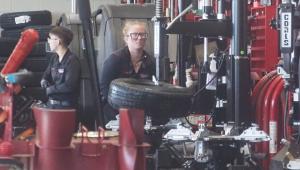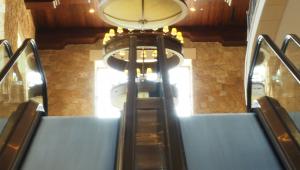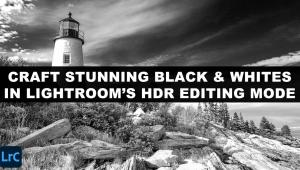LaCie’s 320 LCD Monitor; Three New Professional Display Models From LaCie Page 2
 |
|
|
My workflow now is to begin with the monitor at the default setting and then
launch the calibration and profiling software. I then input my choice of target
aim points in the software and calibrate and profile to those aim points. This
adjusts the display for use as part of the calibration and profiling process.
It all takes less time than it took to write this, and you're then ready
to work with the display.
About the same time as I received the LaCie 320 display I also received delivery
of a new high-performance, wide format printer for test and evaluation. The
tests involved a set of images made with my Canon EOS 5D and a selection of
scanned film images. I won't go into the details of handling all of these
very different kinds of images other than to say that working with the LaCie
320 resulted in excellent quality digital files. Indeed, 100 percent of the
images printed with satisfactory results.
Digital photographic image color correction, adjustment, and editing is done
entirely on a perceptual basis. If you cannot see what is in the image file
reproduced on screen you cannot adjust it effectively or accurately. In that,
the LaCie 320 fully and accurately did the job.
Evaluation And Recommendation
Over the last couple of years I have had the opportunity to use quite a few
new LCD displays. All of them have provided good support for photographic image
processing, editing, and printing. However, when I finished my test work with
these displays and it was time to return them to the manufacturers, I was perfectly
happy to re-install my 21" Sony G520P CRT. With this LaCie 320, however,
I found I was obtaining more effective work and was enjoying better results
from my work than I had with my Sony, so I decided it was time to demote the
Sony CRT to use with another computer and keep the LaCie 320 as my primary display.
Some small part of this good experience, I am sure, is due to the very convenient
hood that comes with the LaCie 320,
which enhances the display's performance. I can say that the images displayed
by the LaCie 320 are smoother, yielding even a satiny appearance compared to
other LCDs I've used.
Although the LaCie is not the most spectacular and impressive LCD display I have used, it is the small, subtle refinements that are most important to me. In all, the refined, precisely accurate reproduction that is the highlight of the LaCie performance should make it a good choice for every discriminating photographer, and at a $1349 list price it is well worth the investment.
Choosing An LCD Display
The 300 Series LaCie display specifications do not seem to be that different
from many other makes and models. And if you visit a computer or office supply
store you won't get much help either as most only display the price leaders
in business and home computer LCD models. If the store does have a high-performance
pro-graphic model it's often in a sealed carton and not on display. Even
if models like the LaCie were displayed it is dubious they would be adjusted
for photographic use, calibrated and profiled, so what you would see on screen
would probably be misleading one way or another.
However, once installed, calibrated, and profiled running Photoshop, the LaCie
320 I used was clearly distinguished from most LCD displays. It reproduced photographic
images with precise refinement, making it easy to control and adjust image values.
But would this same display in a store running at default values be as impressive?
Not on your life!
So, if neither specifications nor what you see displayed in a store are any
indication of what to choose for an LCD display to use for digital photography,
what does one look for?
First, pay careful attention to how the manufacturer describes their market
and the kind of use the display is intended. That is how I have selected the
makes and models I have tested and reported on over the last couple of years,
and it has proved to be a reliable indicator. If the language describing a display
refers to professional graphics, pre-press, or content creation, those are pretty
good clues. But don't depend on a manufacturer referencing digital photography
or professional photography. While they want to be in that market, photography
still seems to be below the radar of computer companies and display manufacturers,
at least this year.
For more information, contact LaCie USA, 22985 NW Evergreen Pkwy, Hillsboro,
OR 97124; (503) 844-4500; www.lacie.com.
For a full list of Technical Specifications, visit the Instant Links section
of our website at: www.shutterbug.com/currentissuelinks/.
- Log in or register to post comments

































